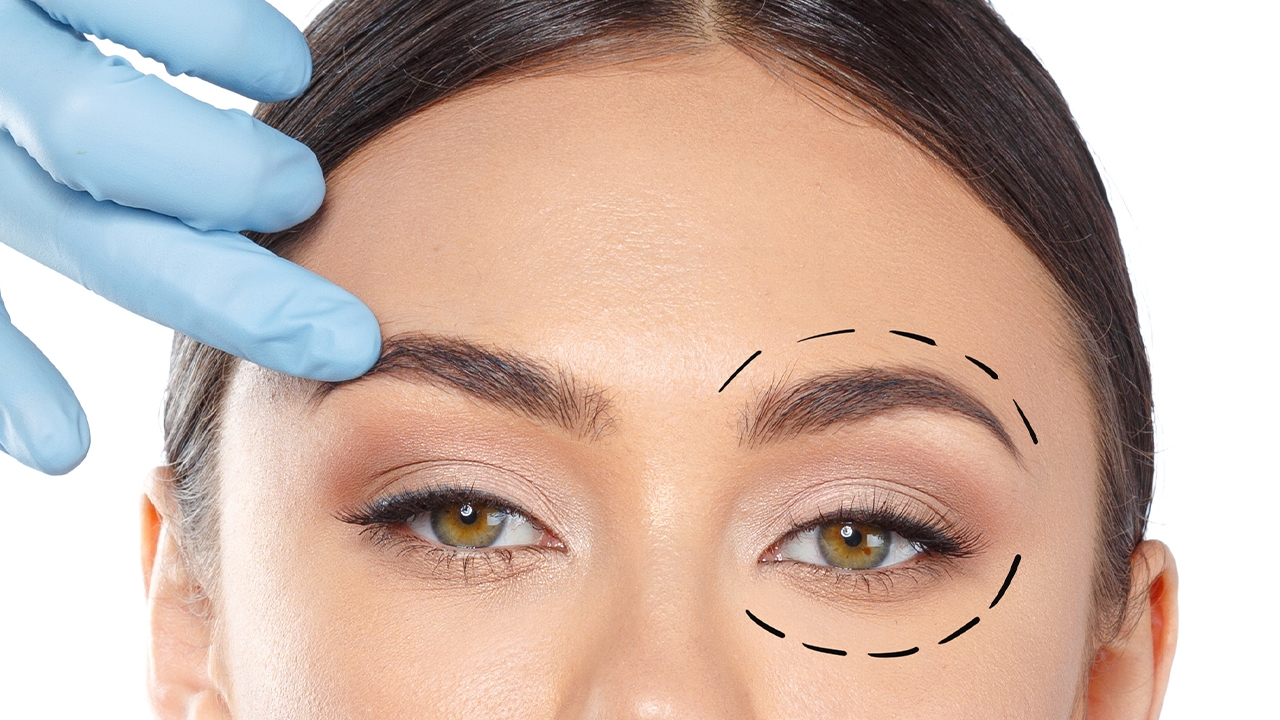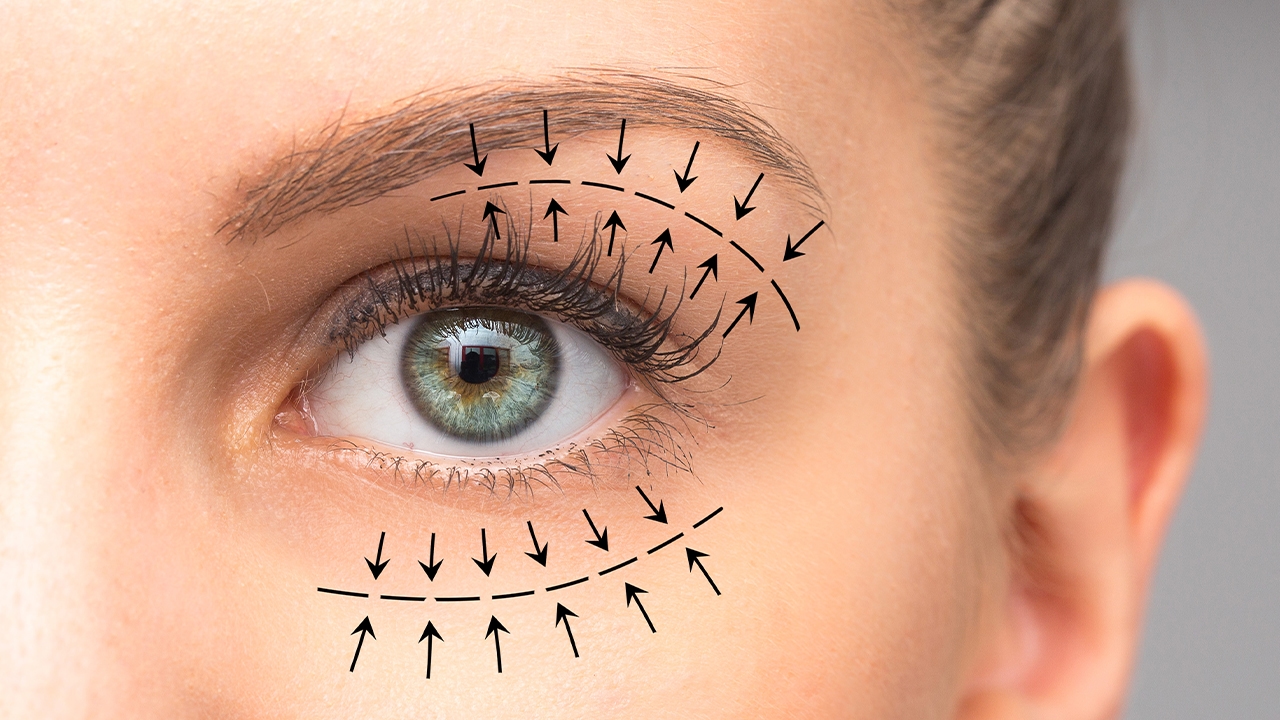Non-surgical eyelid aesthetics refers to a series of applications that do not require surgical intervention to reduce the signs of aging around the eyes. This aesthetic procedure aims to correct sagging, bags, wrinkles and sagging skin on the eyelids. Non-surgical methods are usually minimally invasive, allowing patients to quickly return to their normal lives. Eyelid aesthetics offer a painless and short-term recovery process as an alternative to traditional surgeries such as blepharoplasty.
İçindekiler
ToggleWhat is Non-Surgical Eyelid Aesthetics?
Non-surgical eyelid aesthetics are applications that are performed without the need for surgical intervention and aim to reduce the signs of aging around the eyes. These methods, which are used to correct problems such as drooping eyelids, bags, and wrinkles, are usually minimally invasive.
Non-surgical eyelid aesthetics are applied under local anesthesia with various techniques that affect the muscle and fat tissues under the skin. A younger and more vibrant appearance is achieved with procedures such as eyebrow lift and removal of under-eye bags. These applications are an ideal choice for those who want to avoid surgery or speed up the healing process.

How is Non-Surgical Eyelid Aesthetics Performed?
Non-surgical eyelid aesthetics can be performed with several different methods. The most popular methods include filler applications, needle brow lift, laser treatments, and non-invasive techniques such as ultherapy. These procedures are very effective for correcting wrinkles around the eyes, eliminating under-eye bags, and solving sagging problems. The procedures are performed under local anesthesia, and patients can return to their daily activities immediately after the procedure.
With filler applications, sagging in the lower lids can be corrected by adding a new filler instead of the fatty tissues under the eyes. In addition, cold treatment methods such as ice application help relieve swelling. Patients usually have a rapid recovery process after non-surgical eyelid aesthetics, and swelling and bruising are minimal.
What are the Types of Non-Surgical Eyelid Aesthetics?
Non-surgical eyelid aesthetics can be performed with different techniques. These methods vary depending on the patient’s needs and the problem around the eye. The most common types of non-surgical eyelid aesthetics are:
Filler Application (Hyaluronic Acid):
One of the most frequently preferred methods in non-surgical eyelid aesthetics is hyaluronic acid filler applications. Bags and sagging in the lower eyelid are corrected with this filler. The filler compensates for the loss of volume around the eyes and provides a more youthful appearance.
Ultherapy:
Ultherapy is a method that revitalizes and tightens the skin with sound waves. Sagging in the upper eyelid can be treated with this technique. Ultherapy reaches under the skin around the eyes, stimulates collagen production and tightens the eyelid.
Brow Lift:
Brow lift reduces sagging around the eyes and provides a more open eye appearance. Brow lift is a minimally invasive procedure performed with a needle and is performed under local anesthesia.
Laser Treatment:
Laser treatments to compensate for the loss of elasticity under the skin are also included in non-surgical eyelid aesthetics. Laser reduces sagging by increasing collagen production under the skin.
What Causes Eyelid Sagging?
Eyelid sagging (medically known as “ptosis”) is the positioning of the upper eyelid lower than normal and can affect the field of vision as well as the aesthetic appearance. This condition can occur in one eye or both eyes. There can be many causes of eyelid sagging, and these causes can vary depending on age, genetic predisposition or health condition.
1. Aging
One of the most common causes is aging. Over time, the muscles and connective tissues around the eye weaken, causing a loss of elasticity. This causes the upper eyelid to sag downward. At the same time, the fatty tissues under the skin decrease and the eyelid becomes looser.
2. Genetic Factors
In some individuals, genetic characteristics that are present at birth can cause eyelid sagging. The likelihood of this condition is higher in individuals with a family history of eyelid sagging.
3. Nerve and Muscle Diseases
Weakening of the levator muscle that lifts the eyelid or decreased nerve impulses can cause ptosis. Neurological diseases such as myasthenia gravis and third cranial nerve palsy can cause this condition.
4. Trauma and Surgeries
Blows to the eye or the area around the eye can cause muscle or nerve damage, causing the eyelid to droop. In addition, previous eyelid aesthetic surgery or other surgeries can also trigger this condition.
5. Contact Lens Use
Long-term contact lens use can weaken the muscles that pull the eyelid up and cause sagging over time.
6. Allergies and Eye Diseases
Chronic eye allergies, constant rubbing and irritation of the eye can also cause sagging by causing changes in the eyelid structure.
7. Tumors and Masses
Mass on the eyelid or around the eye can prevent the normal movement of the lid and cause drooping.
Who Can Get Non-Surgical Eyelid Aesthetics?
Non-surgical eyelid aesthetics is especially suitable for patients who do not want surgical intervention or want to get through the recovery process quickly. These methods are generally recommended for people who are 30 years of age and older and who are starting to show signs of aging around their eyes. Since non-surgical techniques are minimally invasive, they are an ideal alternative for those who are hesitant about major surgery such as eyelid aesthetics. In addition, people who want to alleviate conditions such as sagging and bags can also benefit from these applications.
In addition, this application can be preferred for people who have fine wrinkles or age-related skin sagging around their eyes but cannot spare much time. It is also a very effective treatment option for conditions such as drooping eyelids and sagging in the lower lids.
Non-Surgical Eyelid Aesthetics Price

Recovery Process After Non-Surgical Eyelid Aesthetics
Non-surgical eyelid aesthetics usually offer a quick and easy recovery process. However, the recovery period and precautions may vary depending on the method used.
First 24 Hours: Mild swelling, redness or bruising may be observed within the first 24 hours. Applying ice helps reduce the swelling. In addition, care should be taken not to put pressure on the treated area and to protect it from the sun.
First Week: In the first week, swelling and bruising will greatly decrease. Most patients can return to their normal lives a few days after the procedure. The recovery process is rapid in methods such as filler applications.
First Month: In the first month, the eye area gains a tighter and younger appearance. Collagen production increases and skin elasticity improves. The effects after the procedure usually last between 6 months and 1 year.
Things to Consider: Sunlight should be avoided, high factor sunscreen should be used. Physical activities should be avoided for a few days. The area should not be pressured.
The recovery process after non-surgical eyelid aesthetics is usually fast and the risk of complications is low.
Frequently Asked Questions About Non-Surgical Eyelid Aesthetics
Is non-surgical eyelid aesthetics painful?
Non-surgical eyelid aesthetics is usually painless. Since local anesthesia is applied, no pain is felt during the procedure. There may be a slight discomfort after the procedure, but this usually passes in a short time.
Is non-surgical eyelid aesthetics permanent?
Non-surgical eyelid aesthetics usually offer temporary results. Depending on the treatment applied, it shows its effects between 6 months and 1 year. Surgical methods may be preferred for permanent results.
What is the recovery process after non-surgical eyelid aesthetics?
The recovery process varies depending on the method applied. Filling applications and laser treatments usually heal within a few days, but the effects of methods such as ultherapy appear within a few weeks.